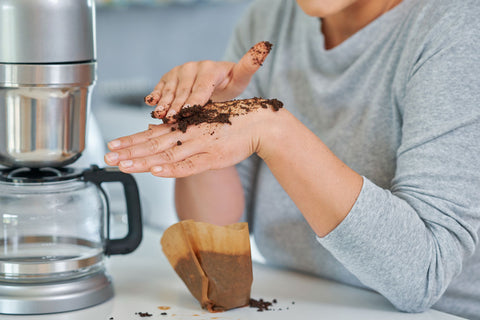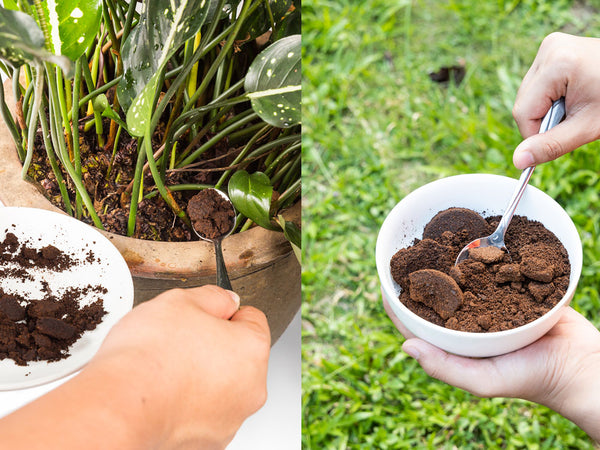When you enjoy your morning cup of coffee, you may not realize that the coffee grounds left in your filter or coffee maker have much more potential than just ending up in the trash. This grounds, rich in nutrients and with surprising properties, can have a second life in your home. In this article, we'll explore eight creative ways to use coffee grounds and reduce your waste.
Introductory note
Before we dive into the fascinating ways to reuse coffee grounds, it's important to understand what exactly this mysterious residue left in our cups and coffee makers is. " Coffee grounds " is the name given to the mixture of solid particles that are separated from the liquid when we prepare coffee. This set of particles includes fragments of ground coffee beans, natural oils and organic compounds that contribute to the characteristic flavor and aroma of this drink.
Beyond simply being a byproduct of coffee preparation, coffee grounds are a valuable and versatile resource that can have multiple uses in our daily lives. From its application in beauty and personal care to its contribution to sustainable practices, coffee grounds become an unexpected ally that deserves to be discovered. Join us in this exploration of how to give a second life to this humble waste and reduce our environmental impact in a creative way. Let's discover how coffee grounds can be a treasure in our home!

How to use coffee grounds
1. Natural Skin Scrub: Coffee grounds are an effective natural exfoliant. Mix it with a little coconut oil or olive oil to create a homemade scrub. You can also use it in the shower to revitalize your skin and reduce cellulite (you will have a peeling effect while its oils and caffeine are great for the skin).

2. Pest Repellent: Dealing with ants or snails in your garden? Sprinkle coffee grounds around affected areas to keep these unwanted pests at bay.
3. Plant Fertilizer: In my opinion the easiest and most common way to use it, coffee grounds are rich in essential nutrients for plant growth, such as nitrogen, potassium and phosphorus. Mix it with your garden soil, add a few tablespoons from time to time to pots or add it to your compost to enrich your plants' substrate.

4. Natural Deodorant for the Refrigerator or Cupboards: Place an open container with coffee grounds in the refrigerator or in areas with bad odors. Coffee will absorb unpleasant odors and keep the environment fresh.
5. Eco-Friendly Cleaning: Dry coffee grounds are a gentle and natural abrasive cleaner. Use it to scrub kitchen surfaces, pots and pans, effectively removing grease and grime.
6. Natural Dye for Art: If you are a crafts lover, use coffee grounds as a natural dye to dye fabric or paper. Boil the marro with water and submerge your materials to give them an aged look.
7. Hand Odor Eliminator: After handling foods with strong odors like garlic and onion, rub your hands with dry coffee grounds to eliminate those lingering odors.
8. Cleaning Kitchen Utensils: Are your kitchen utensils stained or with food remains? Coffee grounds can help you remove unwanted stains and odors. Rub gently and rinse. Additionally, if you have any embedded food, if you rub the sponge with coffee in the pan (or wipe the grounds with a kitchen paper), you will have a peeling effect that will help you remove these remains.
Without a doubt, coffee grounds are a valuable resource that deserves a second chance. Don't see it as waste, but as a versatile resource in your home. Try these eight creative ways to take advantage of it and help reduce your ecological footprint while enjoying the additional benefits of coffee in your daily life. Don't underestimate the power of coffee grounds !
Important Note: The grounds, dry
Before embarking on the exciting adventure of giving your coffee grounds a second life, it is essential to keep in mind one crucial detail: coffee grounds should be used in a dry state for most of their applications. Although it may seem like a minor detail, the difference between wet and dry coffee grounds is essential to the success of your projects.
Why in a dry state? Coffee grounds in a dry state retain their grainy texture and natural properties , and although wet you can use them immediately to do a peeling or clean a pot, if they are not dried and stored properly they could develop mold: wet coffee grounds can develop mold .
To prevent mold on coffee grounds, it is essential to ensure that it is completely dry before storing it in an airtight container or sealed bag. Also, store it in a cool, dry place, away from moisture and direct sunlight.
So, before you dive into the world of coffee grounds possibilities, make sure to dry them completely.
How to dry coffee grounds
Drying coffee grounds is a simple process, it just requires a little time and love. Here is a small step by step on how to do it:
-
Collect Wet Coffee Grounds: After making your coffee, collect the wet coffee grounds from the coffee maker or filter.
-
Spread the Ground: Place the coffee grounds on a baking sheet or flat surface in an even layer. Try not to crowd them so they dry evenly.
-
Let it Air Dry: Leave the tray with the coffee grounds in a well-ventilated place or in indirect sunlight. Avoid direct sunlight, as this can negatively affect the quality of the coffee grounds.
-
Stir Occasionally: During the drying process, stir the coffee grounds occasionally to ensure that they dry evenly on all sides.
-
Wait the Necessary Time: Drying time may vary depending on the ambient humidity and the amount of coffee grounds you are drying (and the thickness you gave it when you spread it on the tray). It can take from several hours to a day or more.
-
Check Dryness: To make sure the coffee grounds are completely dry, touch them with your hands. It should feel crispy and crumbly when ready.
-
Store it: Once dry, store the coffee grounds in an airtight container or sealed bag until you are ready to use them in your projects.
You can also use the food dehydrator for this purpose! Place baking paper on the trays of your dehydrator, and spread the grounds on top of them. Apply 70ºC and, if you have spread it in thin layers, you will see that it dries quickly.























